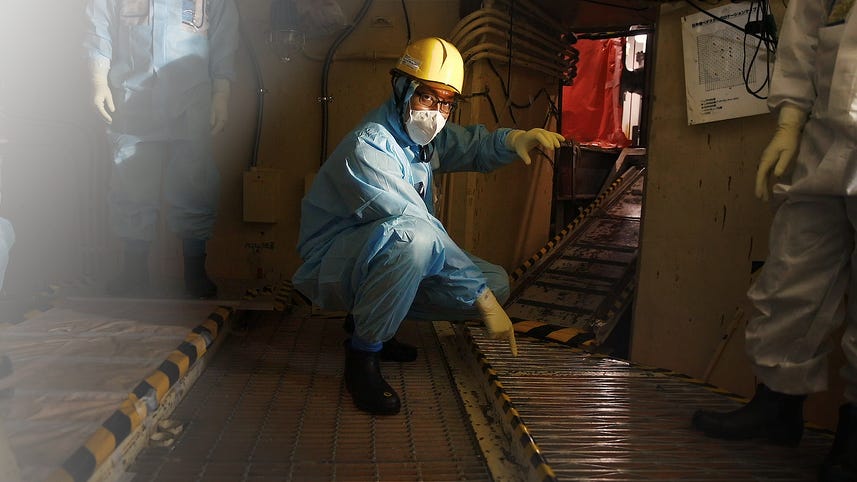
Guitar here and put the camera down to other things.
This cramped crawl space is the heart of a nuclear reactor in the Fukushima Daiichi nuclear power plant, site of the most severe radioactive hotspot in the world.
[MUSIC]
It's going to be two hours of tour so.
Okay.
Two hours of this?
Yeah.
Okay so we are in unit 3, one of the reactors Heavily damaged during the tsunami back in 2011.
You can see the radiation level is so high we can only stay here about ten minutes.
With such extreme conditions, an army of robots, one that can go underwater, take video, maneuver over debri and pick up objects is being listed to do the dirty work too treacherous for humans.
To clean up the worst nuclear disaster in history.
[BLANK_AUDIO]
In 2011, a 9.0 earthquake triggered a tsunami with 50-foot waves that devastated the plant's powers supply so it could not longer cool all the nuclear rods.
The result, a radioactive cocktail of melted fuel rods Concrete, steel, and debris that are made volatile eight years later.
Cleaning up the mess will take at least another generation of workers.
[MUSIC]
The radiation levels are still so high humans can't go near the core.
Even to hang out at the top level reactor over looking the fuel pool, for only a ten minute tour, we had to take extreme precautions.
This is the third layer.
[MUSIC]
JetCo, the Tokyo electric power company which runs the plant, turned to robots for the daunty cleanup of units one, two, and three.
But even robots weren't immune to the hazardous enviornment.
The Scorpion robot, which Toshiba took two and a half years to develop, went into unit two on February 27th Routine, Scorpius mission was to gauge radiation levels and temperatures, but melted metal blocked the robot, and it died just 2 hours into a 10 hour mission, so just getting the robot into the reactor can be tricky.
Atornomous robots can navigate around unexpected obstacles, so team of engineers meticulously controls the robots remotely.
For Units 1, 2, and 3 the robots need to access the reactor's primary containment vessel where much of the core is underwater.
The robots are supposed to enter about midway through the bulbous base of the vessel, sliding down towards the platform.
But unforseen obstructions like debris, and concrete blocks complicate the task.
[MUSIC].
The solution has been to cut a hole to drop in a smaller robotic and let it swim its way to the core.
The 12 by 5 inch submersible robot, nicknamed Sunfish, was the first to successfully record the footage of melted fuel inside a reactor on July 27th.
Since then, Toshiba has returned with another robot to take pictures inside the tube.
To further aid in the cleanup effort, the Japanese government has set up a testing centre near Fukushima, Daishi.
Here, companies can try up their robotics And train operators to pilot machines inside the extreme environment that includes a full room virtual reality experience to let you simulate taking a robot into one of the reactors.
Make a wrong move and a buzzer sounds.
[SOUND]
North of Fukushima Daiichi, local officials are building a robot test field.
They hope it'll attract international companies and researchers looking to test their drones.
The hope is that these facilities will help revitalize the surrounding Fukushima region.
More than 160,000 people were forced to flee their homes after the disaster and many of these communities are still ghost towns.
Most of the evacuated areas won't be safe for many decades.
The ultimate goal is to clean up Daiichi by using these robots, and robots yet to be built, to move and store tons of hazardous material.
It is a painstaking job.
One estimated to cost nearly 76 Billion dollars and take another 40 years.
Sadly, it's a future that many who survived the disaster won't live to see.
[MUSIC]